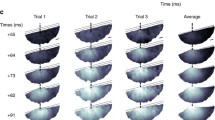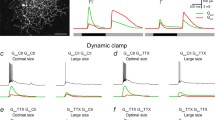Summary
While recording extracellularly from single neurons in the Lateral Geniculate Nucleus (LGN) of cats and monkeys, one often observes, in addition to action potentials, smaller and slower potentials which have been called ‘S Potentials’ (Bishop et al. 1962). Injection of the sodium channel blocker tetrodotoxin (TTX) into the eye of the cat causes spontaneous and light evoked S potentials to disappear. However, electrical stimulation of ganglion cells axons at the optic chiasm still elicits S potentials. Previous studies have shown that retinal ganglion cell impulses elicit S potentials. Our results prove that ganglion cell impulses are the ONLY source of these potentials; therefore, one can use them as a measure of ganglion cell input to the LGN.
Similar content being viewed by others
References
Bishop PO, Burke W, Davis R (1958) Synapse discharge by single fibre in mammalian visual system. Nature 182: 228–230
Bishop PO, Burke W, Davis R (1962) The interpretation of the extracellular response of single lateral geniculate cells. J Physiol (Lond) 162: 451–472
Burke W, Cole AM (1978) Extraretinal influences on the lateral geniculate nucleus. Rev Physiol Biochem Pharmacol 80: 106–166
Cleland BG, Dubin MW, Levick WR (1971) Sustained and transient neurons in the cat's retina and lateral geniculate nucleus. J Physiol (Lond) 217: 473–496
Eysel UTh, Grüsser O-J (1975) Discharge patterns of lateral geniculate neurons after acute, local retinal lesions. Exp Brain Res 23 (Suppl): 68
Hubel DH, Wiesel T (1961) Integrative action in the cat's lateral geniculate body. J Physiol (Lond) 155: 385–398
Kaplan E, Shapley RM (1982) X and Y cells in the lateral geniculate nucleus of macaque monkeys. J Physiol (Lond) 330: 125–143
Lee BB, Virsu V, Creutzfeldt OD (1983) Linear signal transmission from prepotentials to cells in the macaque lateral geniculate nucleus. Exp Brain Res 52: 50–56
Levick WR, Cleland BG, Dubin MW (1972) LGN neurons of the cat: Retinal inputs and physiology. Invest Ophthalmol 11, No. 5: 302–311
McIlwain JT, Creutzfeldt OD (1967) Microelectrode study of synaptic excitation and inhibition in the lateral geniculate nucleus of the cat. J Neurophysiol 30: 1–21
Milkman N, Schick G, Rossetto M, Ratliff F, Shapley R, Victor J (1980) A two-dimensional computer controlled visual stimulator. Behav Res Meth Instrum 12(3): 283–292
Singer W, Creutzfeldt O (1970) Reciprocal lateral inhibition of on- and off-center neurons in the lateral geniculate body of the cat. Exp Brain Res 10: 311–330
Singer W (1977) Control of thalamic transmission by corticofugal and ascending reticular pathways in the visual system. Physiol Rev 57: 386–420
So YT, Shapley RM (1981) Spatial tuning of cells in and around lateral geniculate nucleus of the cat: X and Y relay cells and perigeniculate interneurons. J Neurophysiol 45: 107–120
Author information
Authors and Affiliations
Rights and permissions
About this article
Cite this article
Kaplan, E., Shapley, R. The origin of the S (slow) potential in the mammalian Lateral Geniculate Nucleus. Exp Brain Res 55, 111–116 (1984). https://doi.org/10.1007/BF00240504
Received:
Issue Date:
DOI: https://doi.org/10.1007/BF00240504




